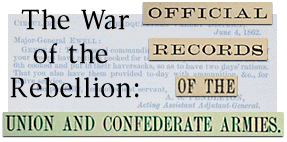Summary:
Robert E. Lee writes Thomas J. Jackson on Union and Confederate movements in
November, 1862, in preparation for the Fredericksburg campaign. He mentions the
situation around Staunton.
Lieut. Gen. THOMAS J. JACKSON,
Cmdg.,&c.:
Camp near Culpeper Court-House,
November 18, 1862
GEN.:
Your letter of the 17th is just received. I think there must be some mistake about the enemy's being re-enforced at Harper's Ferry, inasmuch as information from Washington states that nearly all the troops near the city have been advanced into Virginia. I fear I was said to be threatening Staunton had retired beyond at Alleghanies. I therefore have ordered the First South Carolina Cavalry and Stribling's battery to Gordonsville. I think the force there, with Imboden operating in advance, will be sufficient to protect that place, as in a short time the roads in that country will be impassable.
If the report that the enemy is returning in force to Middleburg is correct, it must be owing to your presence in the valley and the operations of the cavalry; but, in that event, it would appear that they are in great force at all points from Harper's Ferry to Fredericksburg. There must be error somewhere, and it is important to discover it. In a telegraphic dispatch sent you half an hour since I have you in substance the result of my information. I will report more in detail.
The reports from our cavalry, individual scouts, and citizens, represent that the enemy has abandoned Warrenton, fallen down to the Orange and Alexandria Railroad, and is moving in force to Fredericksburg. Their progress and direction is confirmed by their camp-fires at night, which are said to be plainly visible. A large force was reported yesterday, in addition, at Brentsville;it had come from the direction of Alexandria. The cavalry, with light artillery, reached Falmouth yesterday about 3 p.m. Their infantry were said to have reached Hartwood last night; their camp-fires distinctly visible, extending continuously back toward the railroad. An intelligent scout reports this morning that it was Sumner's corps, and that no other troops had passed up to late yesterday. The enemy's cavalry were prevented from crossing the Rappahannock last evening by our troops in Fredericksburg, nor have I yet heard of its occupation. There are in Fredericksburg a regiment of cavalry, one of infantry, and two additional companies, and two light batteries. McLaws' division marched this morning for that place; also Lee's brigade of cavalry, and Ransom's division from Madison. The rest of Longstreet's corps is prepared to move, and only awaits confirmation of intelligence.
Stuart, with his cavalry, was directed to cross the Rappahannock to-day, and endeavor to ascertain what was in our front and what movements were being made by the enemy. I presume I shall not hear from him till to-morrow; but unless you think it is advantageous for you to continue longer in the valley, or can accomplish the retention and division of the enemy's forces by so doing, I think it would be advisable to put some of your divisions in motion across the mountains, and advance them at least as Sperryville or Madison Court-House. I telegraphed you to this effect to-day. I learn that there are not transports at Alexandria; nothing but a few gunboats and tugs. I see, therefore, no preparation for the transfer of the enemy's troops south of the James River as yet; nor is there anything to develop their ultimate plan. It is possible that the may attempt to seize Winchester, Culpeper, and Fredericksburg, which would embrace their favorite strategic plan of advancing in three columns, but I think by so doing they will much expose themselves. I hope we may be able to take advantage of it.
I hope more shoes and blankets have arrived for your men, and that you will be enabled to keep them comfortable and in health.
I am, most respectfully, your obedient servant,
R. E. LEE,
Gen.
Bibliographic Information : Letter Reproduced from The War of The Rebellion: Official Records of the Union and Confederate Armies, Series 1, Volume 21, Serial No. 31, Pages 1018-1019, Broadfoot Publishing Company, Wilmington, NC, 1997.

